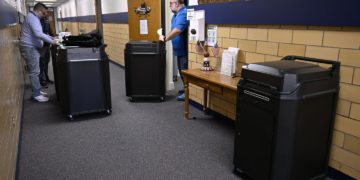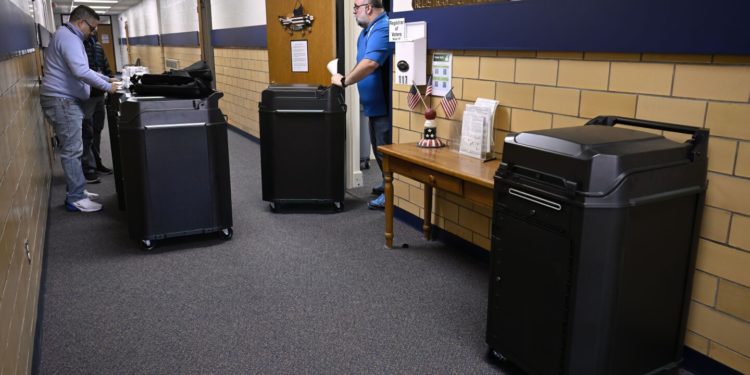ATLANTA — President Donald Trump’s seeking to change is creating uncertainty for state and local election officials and worries about voter confusion before the next federal election, the 2026 midterms.
Election officials were already dealing with the from the federal government and now face the potential for that include a new voter registration requirement, decertification of certain voting systems and stricter ballot deadlines for many states.
In Connecticut, Secretary of the State Stephanie Thomas is hopeful that ballot scanners the state just bought for $20 million will be acceptable under the executive order, but she worries about other states.
“It’s not like states have millions and millions of dollars that they can just upgrade their election equipment every couple of years,” said Thomas, a Democrat. “Imagine people purchased new equipment and now it no longer can be used. There is no remedy for that in the order.”
Because Trump’s order is , it’s unclear what will be required and when. That means more uncertainty for election officials.
“I have no idea what the timeline is for things in the executive order,” said Joseph Kirk, who oversees elections in Bartow County, Georgia. “I really hope we have some clarity on some of this stuff soon because no matter what the answers are, I need to take care of my voters.”
Order inserts the federal government into state election operations
In the order Tuesday, Trump criticized the work of election officials across the country and praised how other nations conduct their elections. Trump has long questioned the integrity of U.S. elections, , when the Republican won the Electoral College but lost the popular vote to Democrat Hillary Clinton, that his support would have been higher if not for large numbers of noncitizens voting in California.
Trump his 2020 loss to Democrat Joe Biden was the result of a “rigged” election. There is and , with multiple in the states where Trump challenged the outcome confirming his loss.
In the years since, election officials in many parts of the U.S. have endured , a barrage of by groups skeptical of their work and pushed by state lawmakers who argue new restrictions are necessary to restore public confidence.
Trump’s order, combined with recent decisions by his administration to and for a dedicated information-sharing network for election offices, have prompted concern about the role of the federal government in elections moving forward.
“States run our elections, but the federal government has been an important partner in assisting election officials,” said Larry Norden, an election security expert with the Brennan Center for Justice. “To be a partner, you have to be trusted. You have to provide consistency and certainty. The last few months have utterly destroyed that.”
Concerns about requirement to prove US citizenship
One of the major changes outlined in the executive order is a requirement for people to show documentary proof of U.S. citizenship when they register to vote. That is something Republicans in Congress , but the effort stalled amid Democratic opposition in the Senate.
House Republicans with the Safeguard American Voter Eligibility Act, known as the SAVE Act. A House committee is scheduled to discuss the bill on Monday.
After the executive order, several Republicans who are top state election officials issued statements praising provisions that direct federal agencies to help states verify voter eligibility and citizenship. Their Democratic counterparts have been more critical.
Voting rights groups are raising concerns about the citizenship requirement. They say millions of Americans do not have easy access to their birth certificates, only about half have U.S. passports, and married women would need multiple documents if they have changed their name.
While voting by noncitizens does occur, it typically involves and is more often rather than an intentional and coordinated attempt to subvert an election. It also can lead to felony charges and deportation. Under Trump’s order, the burden would fall to election officials to implement this requirement. Experts say that would be expensive and there’s no additional federal money to help pay for it.
“It’s creating an entirely new bureaucracy in every single state for the collection of that data, for the storage of that data, and for the retrieval of that data,” said David Becker, a former Justice Department lawyer who leads the Center for Election Innovation & Research. “You don’t wave a magic wand and do that.”
Increasing risk of voter confusion
Kate Sweeney Bell, who oversees elections in Indiana’s Marion County, said she does not expect major problems in her state because it has restrictive voting laws that she says have resulted in some of the lowest voter turnout in the country. She worries, though, about the rest of the U.S. and the amount of public education that will be needed to ensure voters are aware of whatever changes are made.
“I feel for every other state that doesn’t have the prohibitive laws that Indiana does, because it’s a rough couple of election cycles when changes like this are made,” Sweeney Bell said.
One challenge is the likelihood that protracted legal battles will delay clarity for both election officials and the public.
“If election officials are uncertain about the rules, there is no doubt that voters will not understand them — creating distrust in the process and ultimately in the validity of the outcome,” said Ryan Macias, an election security and voting systems expert.
The uncertainty comes as election officials are preparing for the 2026 elections. Dean Logan, who oversees elections in Los Angeles County, said running a successful election depends on extensive planning, a trained workforce and proper equipment.
“Last-minute changes or unilateral mandates significantly increase the risk of voter confusion and operational inconsistencies and can erode voter confidence,” he said.
Order could lead to changes in voting machines, without paying for it
Trump’s order also targets voting systems in a way that could require some counties to change machines without offering additional money to help them pay for it. It directs the U.S. Election Assistance Commission, an independent and bipartisan agency created by Congress, to amend voluntary standards for voting systems to prohibit devices that use a barcode or QR code on ballots, with an exception for ones designated for voters with disabilities.
The order calls for the commission within 180 days to review, recertify where appropriate and rescind “all previous certifications of voting equipment based on prior standards.” Beyond the legality of the order, experts say federal law outlines specific procedures and public comment periods for updating the standards.
While there are voting systems that do not use barcodes, the process for states to replace equipment takes time, said Mark Lindeman, policy and strategy director with Verified Voting, which focuses on election technology. Election offices must get approval to spend for new voting systems, go through a procurement process, wait for manufacturers to deliver the equipment and eventually train workers on how to use it.
“It’s hard for any state to procure and obtain and test new voting systems, and if there was some mad rush for many states to replace their voting systems at once, we don’t know how many systems manufacturers could supply,” Lindeman said.
___
Associated Press writer Susan Haigh in Hartford, Connecticut, contributed to this story.
The post Trump’s election order creates much confusion before the next federal election in 2026 appeared first on Associated Press.



















